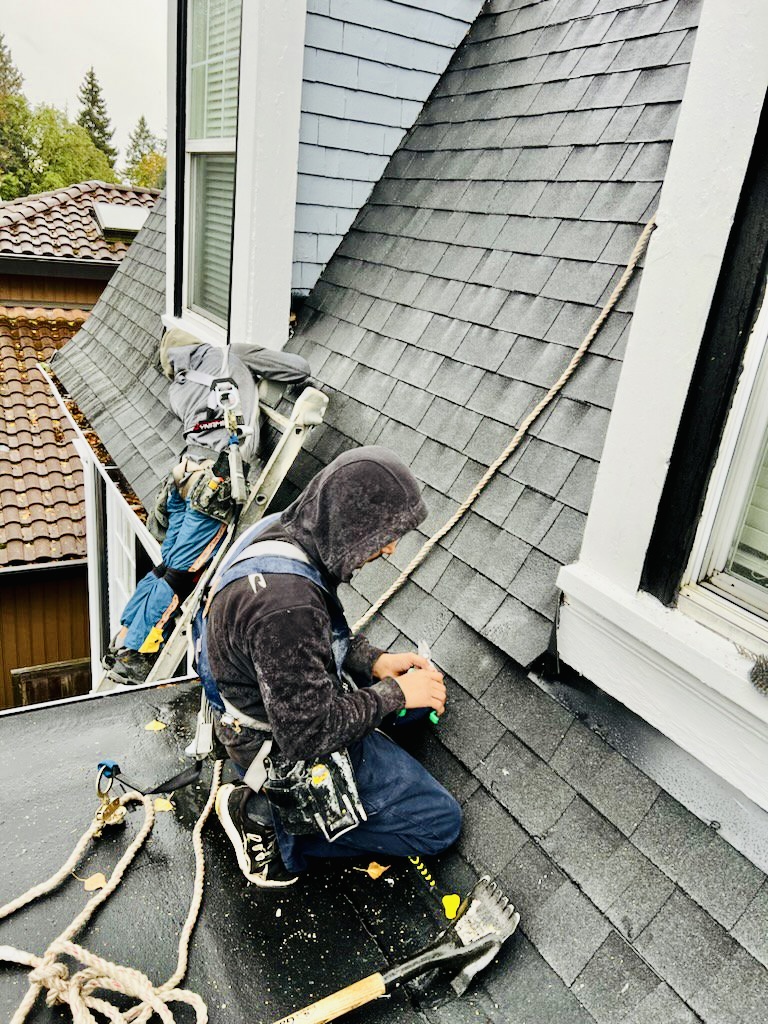Roof shingles are one of the most popular roofing materials in North America, offering durability, affordability, and aesthetic appeal. However, even the best asphalt shingles won’t last if they aren’t installed correctly. A poorly installed roof shingles system can lead to leaks, premature aging, and costly repairs. Whether you’re hiring a roofing contractor or tackling the job yourself, understanding these common mistakes can save you time and money.
Why Proper Installation of Roof Shingles Matters
Getting roof shingles installed the right way is just as important as choosing the right material. Even the best shingle roofing won’t last if it’s not put on properly. In fact, industry experts say that poor installation is one of the main reasons roofs fail too soon. When mistakes happen, they can lead to:
- Leaks and Water Damage – Gaps or misaligned shingles allow water to seep in, causing rot and mold.
- Higher Energy Bills – Poor insulation leads to heat loss in winter and extra cooling costs in summer.
- Shorter Roof Lifespan – A roof that should last decades may need repairs or replacement much sooner.
- Voided Manufacturer Warranties – Many roofing companies won’t cover issues caused by improper installation.
A shingle roof is a long-term investment, and taking shortcuts during installation can lead to costly repairs down the road. That’s why it’s crucial to hire skilled professionals and follow proper techniques.
Now, let’s go over the seven most common mistakes roofing contractors make when installing asphalt shingles—and how to avoid them.
7 Common Mistakes Roofing Contractors Make Installing Roof Shingles
1. Putting Nails in the Wrong Spot
Believe it or not, nails are one of the most important parts of installing roof shingles. If they’re placed incorrectly, it can lead to big problems later on. You might see shingles coming loose or even flying off your roof in bad weather.
Here are some mistakes people often make:
- Not using enough nails per shingle: If there aren’t enough nails, shingles can easily shift or fall off.
- Nailing too high up on the shingle: Nails placed too high won’t hold the shingles securely, especially when winds pick up.
- Hammering nails too hard: This pushes the nail straight through the shingle, creating holes and leaks.
How to Do It Right:
Always check the instructions that come with your asphalt shingles. Usually, manufacturers suggest using four to six nails per shingle, placed right in the marked area (called the nailing strip). It’s also smart to pick nails that won’t rust, because rusty nails can cause problems sooner than you expect.
2. Misaligned Roof Shingles
When shingle roofing isn’t lined up properly, it can leave gaps that let in wind and moisture. Over time, this can lead to leaks, damage, and costly repairs. Some common mistakes include:
- Crooked rows – If roof shingles aren’t installed in a straight line, they won’t look right and won’t provide proper coverage.
- Incorrect overlap – If shingles aren’t layered correctly, they won’t keep water out the way they should.
- Too tight of a fit – Asphalt shingles need a little space to expand and contract with temperature changes. If they’re packed too tightly, they can buckle or warp.
How to Get It Right:
Roofers use chalk lines to keep shingle roofs straight and evenly spaced. Proper alignment not only looks better but also helps rainwater drain off the roof properly, reducing the risk of leaks. If you’re planning a new roof or repairs, searching for ‘roofing contractors near me’ in Google can help you find a pro who will get the job done right.
3. Neglecting Roof Ventilation
Poor ventilation can cause excessive heat buildup in the attic, leading to premature aging of roof shingles. In fact, proper attic ventilation plays a crucial role in extending the life of a roof by reducing heat buildup and preventing moisture-related issues, as highlighted by Natural Resources Canada (NRC).
Signs of inadequate ventilation include:
- Ice dams forming in winter
- High energy bills due to heat retention
- Warped or curled shingles due to heat exposure
Solution: Ensure the attic has adequate intake and exhaust vents to maintain proper airflow and regulate temperature. Proper ventilation extends the life of your roof shingles while improving overall energy efficiency.
4. Skipping the Starter Strip
A solid shingle roofing job isn’t just about laying down roof shingles—it’s also about getting the details right. One step that often gets overlooked is the starter strip. This thin strip at the roof’s edge helps keep water from sneaking under the first row of asphalt shingles, yet some roofing contractors near you might skip it. When that happens, here’s what can go wrong:
- Shingles start curling at the edges, making the roof look worn out faster.
- Strong winds can lift the shingles, making them more likely to tear or blow off.
- Water seeps underneath, leading to leaks and moisture damage.
What to Do: Before laying the first row of shingle roofs, always install a starter strip along the eaves. It’s a small step that makes a big difference in keeping your roof strong and weatherproof.
5. Poor Flashing Installation
Flashing might not be the most noticeable part of a roof, but it’s one of the most important. It seals up weak spots around chimneys, skylights, and roof valleys to keep water out. If flashing is installed the wrong way, you’re asking for trouble. Here are some common mistakes:
- Using old, rusty, or damaged flashing instead of replacing it.
- Relying on caulk instead of proper metal installation, which won’t hold up over time.
- Not overlapping the flashing correctly, creating gaps where water can sneak in.
What to Do: Always use new, high-quality flashing and install it properly with waterproof materials. Flashing needs to be tight, secure, and well-sealed—especially in rainy climates like Vancouver. A little extra effort here can save you from costly water damage later.
6. Inadequate Underlayment
The underlayment serves as an additional barrier against moisture. Skipping or using low-quality underlayment can lead to roof leaks and rot. The wrong underlayment can also compromise the manufacturer’s warranty.
Solution: Use high-quality synthetic or felt underlayment that meets industry standards. The Roofing Contractors Association of British Columbia includes synthetic underlayment as an accepted material in its RoofStar Guarantee Program due to its durability and water resistance (RCABC). Installing ice and water shields in areas prone to heavy rainfall or snowfall further enhances protection.
7. Failing to Follow Manufacturer’s Guidelines
If shingles are not installed according to manufacturer recommendations, they can deteriorate faster and become more prone to damage. Many homeowners also encounter various problems with shingle roofing over time, even if installed correctly. Understanding these potential issues can help you maintain a long-lasting roof. For more insights, check out our guide on 7 Common Problems with Shingle Roofing (and How to Fix Them). Each roof shingles manufacturer has specific installation instructions to ensure longevity and performance. Ignoring these guidelines can:
- Void product warranties
- Lead to structural failures
- Result in premature shingle deterioration
Solution: Contractors should always follow the manufacturer’s instructions, including nail placement, overlap requirements, and ventilation recommendations. Homeowners should also verify that the contractor adheres to these guidelines before the installation begins.
How to Find Reliable ‘Roofing Contractors Near Me’ in any searching platforms
Choosing the right contractor is crucial for a successful roof shingles installation. With so many options out there, how do you know you’re hiring the best? Here’s how to find ‘roofing contractors near me’ who can get the job done right:
- Check Licenses & Certifications – Always hire a contractor who is licensed, insured, and qualified to install roof shingles. This protects you from liability and ensures quality work.
- Ask for References & Past Work – A reliable contractor should provide customer reviews and show examples of completed shingle roofing projects. Looking at their past shingle roofs can help you gauge their expertise.
- Review Warranties & Contracts – A trustworthy contractor will give you a written estimate, a clear contract, and a warranty for your roof shingles installation. This ensures transparency and long-term protection.
- Look for Industry Affiliations – Contractors associated with organizations like the NRCA or RCABC are often more reliable and follow industry best practices.
- Request a Detailed Estimate – A professional should provide a breakdown of materials, labor, and any additional costs so you know exactly what to expect.

Extra Tips for Homeowners
- Schedule Regular Roof Inspections – Having a professional inspect your roof shingles every 1-2 years can help catch minor issues before they become major repairs.
- Keep Your Gutters Clean – Clogged gutters can cause water to back up under your roof shingles, leading to leaks and water damage. Regular cleaning helps prevent this.
- Watch for Weather Damage – After a storm, check your asphalt shingles for missing or lifted edges. Catching problems early can save you from costly repairs.
Final Thoughts
A properly installed roof shingles system can last for decades, but only if it’s done right. Avoiding common mistakes and working with skilled professionals ensures your asphalt shingles perform as expected, keeping your home protected for years to come.
Looking for ‘roofing contractors near me’? Contact our trusted experts today to ensure a durable, long-lasting roof shingles system!

